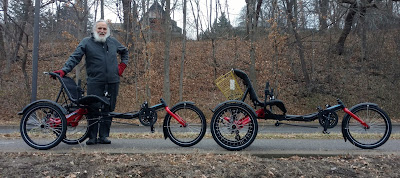Hase Trigo -- Why We Chose Them
The back-story
We have been riding delta-style recumbent trikes (one wheel in front and two in back) since 2007, starting that year with one Greenspeed Anura and one Hase Kettwiesel. Their adaptability for people with disabilities immediately impressed us, and we began recommending them for rehab use.Many disabled people lack the ability to transport a trike, aren't familiar with the various models, and can't just drive as much as a couple hundred miles to buy one. We started providing that kind of assistance to people whose budgets didn't stretch to buying a new trike, identifying and obtaining good used trikes that they could afford. Even if nobody had made a specific request, we would buy trikes that had been set up for a particular disability and then look around for someone who needed that adaptation. It's been a bit of a hobby, helping heirs find new homes for rehab trikes after the first owners passed away, and getting disabled people onto good trikes for much less than they cost new. Along the way, we got the chance to try out a lot of equipment and meet nice people -- but this didn't scale up beyond two to five cases a year.
In 2017, Tommy Dixon and Caito Bowles-Roth started the Twin Cities Adaptive Cycling Program in Minneapolis, and we saw a chance to expand our activities. People who might not have space to store an adapted cycle, the ability to transport one, or the money to buy one can use the program's trikes, tandems, and handcycles to ride on the Midtown Greenway and the linked trails. We joined the program as volunteers and brought along some trikes that we had acquired.
After a summer of adjusting trikes to fit a variety of riders -- changing boom lengths, moving seats, switching pedals, and trying out different models to find the best fit -- we had a lot of opinions about how these trikes could be easier to work with. Trike manufacturer Hase in Germany could have been reading our minds! It released its Trigo trike at the end of 2017, promising a wider range of positions and size accommodations than any other trike on the market, with quick and easy (and mostly tool-free) adjustments.
Where the Trigo comes in
While many riders will fit a bike or trike once, and never change it, a program that serves riders of different sizes really benefits from easy adjustments. The ease and speed of setting up the Trigo between riders would let them spend more time enjoying the ride, while reducing the work for volunteers and staff of the program. A smaller number of very adaptable trikes could serve as many people as a bigger fleet of trikes that might be able to fit only a few different riders.
That adjustability has some advantages for the manufacturer, the retailer, and the rider, too. One model that suits many people is easier to build, stock, and buy -- and easier to re-sell when the time comes.
In posting about the Trigo, we'll try to cover the features that are relevant to both the individual user and the program that needs to serve a larger number of riders. We're daily riders ourselves, using trikes for touring, recreation, commuting (until we retired in 2014), and errands. We believe that a trike should be sporty, nice-looking, and comfortable, even (or especially) if it's being used for rehab.



Great review thanks. As I age my tadpole trike appeals less to me when I try to get up from it. I'm looking at a Trigo as a sensible solution for shopping, travel, recreation etc. Do keep posting. Your thoughts are very welcome. Have fun.
ReplyDeleteCheers
Graeme